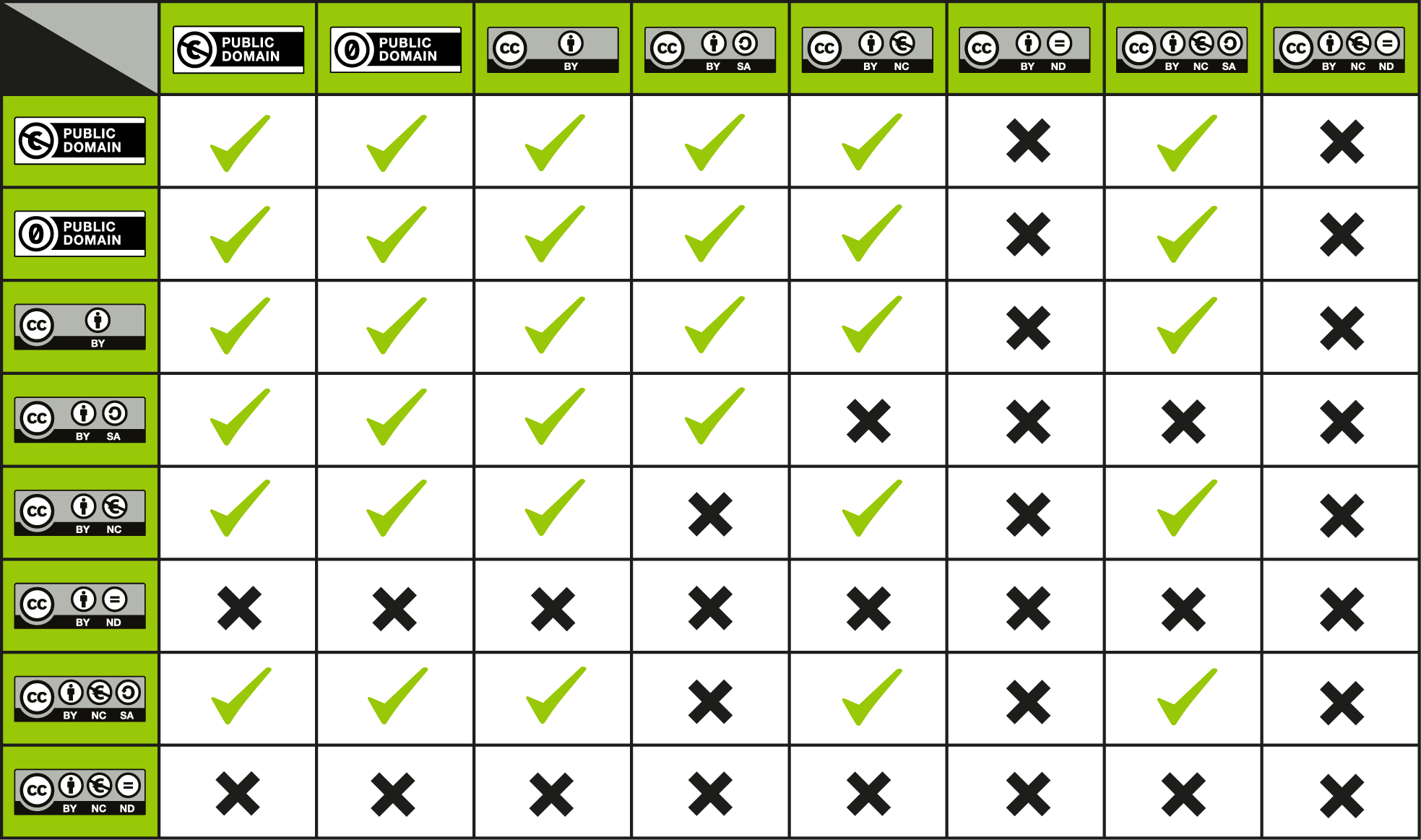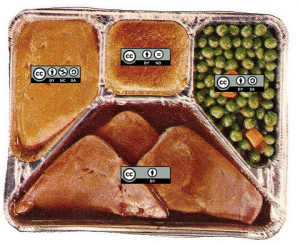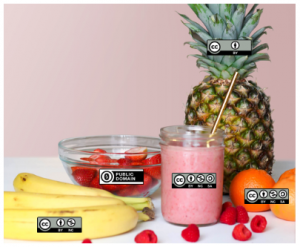Besides licensing your own original Creative Commons works, you may decide to reuse or adapt an existing CC-licensed work or works. It is always okay to use and share a CC-licensed work, but the license specifies what you can do beyond that--whether and how you can share your own adaptations, and whether you can use the work for commercial purposes.
If you are using more than one CC-licensed work in your work, you will need to consider the individual license of each work to determine:
Before you can answer these questions, you must decide whether your use of a particular work counts as an adaptation.
Adaptations (also called derivatives or remixes) are works based on existing works. The legal definition of adaptation varies internationally, but most require a level of originality in the new work. Examples of adaptation include translating a work into a different language and making a film based on a novel.
Not all changes to a work are considered adaptations. For example, spelling corrections and formatting changes (e.g. from digital to print) are generally not adaptations.
Licensing Compatibility
You can adapt or remix content from multiple CC-licensed works into a new derivative work. However, different CC licenses have different specifications for whether and how adaptations can be shared. This means some types of CC-licensed works are incompatible with each other and cannot be used together in a single adaptation.
For example, CC licenses including the share-alike (SA) component require that adaptations have the exact same license, so a CC-BY-SA work and a CC-BY-NC-SA work cannot be combined. The presence of the non-commercial (NC) component in one license but not the other makes these two licenses incompatible. A CC-BY-NC-SA work could be combined with a CC-BY work; the resulting adaptation could be licensed CC-BY-NC-SA and be fully compatible with the licenses of both original works.
This chart shows which types of works can and cannot be combined in an adaptation.

CC License Compatibility Chart by Creative Commons, licensed CC-BY 4.0
Licensing Adapted Works
Besides selecting compatible works for your adaptation, you will need to license your new work with a compatible license. The adapter's license chart below shows which licenses you could apply, based on the license of the original work. If the box is green, you may use that license. Yellow shading indicates that the license is technically permitted, but Creative Commons does not recommend this usage. If using one of the yellow-shaded pairs, Creative Commons advises you to clearly mark that the adaptation includes works with multiple copyrights, so that subsequent users understand the adaptation includes content with more restrictive copyright obligations. Gray shading indicates an adapter's license that is incompatible with the original work and should not be used.
If you are combining multiple compatible works, selecting the most restrictive license and applying that license to your work is good practice to follow.
Adapter's License Chart by Creative Commons, licensed CC-BY 4.0
Learn more about reusing CC-licensed works, including adaptations/remixes and collections.
If you are not making changes to a CC-licensed work, it may not be an adaptation, even if you are incorporating the work into a new, different work. Consider an anthology of openly-licensed essays from a variety of sources, or a digital album of CC-licensed photos collected on a particular topic. If the original works are not changed when they are compiled together, these are examples of collections, not adaptations.
Collections assemble independent works into a new creation, without changing the independent work.
The legal distinction between collections and adaptations can be complicated, and varies depending on jurisdiction. One analogy that can be helpful is to think of collections as TV dinners, and adaptations as smoothies.
In a TV dinner/collection, each of the components is clearly identifiable and can stand alone. In a smoothie/adaptation, ingredients are blended and changed in such a way that they cannot be independently isolated in the new creation.

“CC TV Dinner” by Nate Angell. CC BY. Derivative of “tv dinner 1″ by adrigu (https://flic.kr/p/6AMLDF) used under CC BY, and various Creative Commons license buttons by Creative Commons (https://creativecommons.org/about/downloads) used under CC BY.

“CC Smoothie” by Nate Angell. CC BY. Derivative of “Strawberry Smoothie On Glass Jar” by Element5 (https://www.pexels.com/photo/strawberry-smoothie-on-glass-jar-775032/) in the public domain, and various Creative Commons license buttons by Creative Commons (https://creativecommons.org/about/downloads) used under CC BY.
Licensing considerations are different for collections than for adaptations. Attribution and licensing information must be included for each included work, but each work stands alone. Licensing compatibility is not applicable to collections.
You may apply a copyright to your collection, and the license you select does not need to be the same as or compatible with the licenses of the works in the collection. The copyright license you select applies only to your contributions to the work, including your selection and arrangement of works and any additional content you create, such as an introduction. It does not apply to the original creative works of others that you have included in your collection.

 FYSE 125: Travel Narratives by Gretchen Scronce is licensed under a Creative Commons Attribution 4.0 International License. This work is a compilation of the following images (clockwise from top): "Everyday Explorers Travel Journal Kit" by Christine Herrin, licensed under CC BY-NC-ND 4.0 ; "Mercado" by Wild Rose Dogs, licensed under CC BY-NC-SA 2.0; "See South America" by Steve Forney, licensed under CC BY-NC-ND 4.0; "File:62965-Peru Huayhuash.svg" by Berria, licensed under CC BY-SA 4.0
FYSE 125: Travel Narratives by Gretchen Scronce is licensed under a Creative Commons Attribution 4.0 International License. This work is a compilation of the following images (clockwise from top): "Everyday Explorers Travel Journal Kit" by Christine Herrin, licensed under CC BY-NC-ND 4.0 ; "Mercado" by Wild Rose Dogs, licensed under CC BY-NC-SA 2.0; "See South America" by Steve Forney, licensed under CC BY-NC-ND 4.0; "File:62965-Peru Huayhuash.svg" by Berria, licensed under CC BY-SA 4.0
 Copyright Guide by Gretchen Scronce is licensed under a Creative Commons Attribution 4.0 International License (CC-BY).
Copyright Guide by Gretchen Scronce is licensed under a Creative Commons Attribution 4.0 International License (CC-BY).